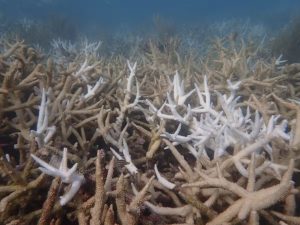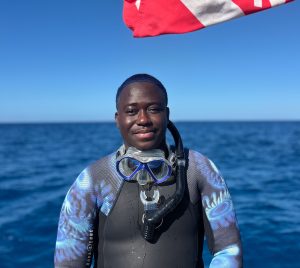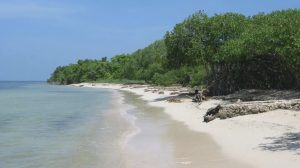Anybody who has visited The Bahamas or the Caribbean region knows it for the glorious tropical weather, white sand beaches, crystal-blue water, and beautiful coral reefs. The natural beauty is unmatched, both above and below the water. In the past several years, you’ve probably also seen stunning aerial photos and videos on social media, taken with drones flying tens or hundreds of feet up in the air, that capture the shocking colors of the ocean, the activities of boaters, or people playing on beaches. These images are striking, and are becoming increasingly accessible as the technology improves and gets cheaper.

A birds-eye perspective of our research boat in The Bahamas.
What you may not know is that these drones can be so, so much more useful than just flying cameras to get the perfect content for your instagram posts.
At PIMS, much of our work is targeted at monitoring, conserving, and restoring the biodiversity of the marine ecosystems, especially coral reefs, that are critical to the natural beauty, economy, and ecological health of The Bahamas. One of the challenges we face is that reefs are vast and spread out across the shallow waters surrounding the islands, making it difficult to visit more than a small selection of sites. This, combined with the simple fact that moving around underwater is slow and cumbersome, makes it hard to get the full picture of where reef sites are, not to mention how healthy they are. Historically, researchers have relied on aerial surveys from planes to get “the big picture”, or have used remotely-sensed satellite data. While useful, these platforms are fairly limited. Plane flights are expensive and rely on airports, while satellite photos aren’t high-resolution enough to really see what’s under the water.

A 3D model of a mangrove ecosystem. Blue squares show the locations of the drone photos used to create the model.
Finally, as technology has improved, remotely-piloted drones have become a cost-effective and incredibly powerful solution to our problem. We can launch them from virtually anywhere – even from a boat – and use them to collect ultra-high resolution photos and videos from a birds-eye view. Fortunately for us, Bahamian waters are renowned for their clarity, and most coral reefs are in shallow water, which means that drone cameras can see into the water, and give us vital information about reef structure and health that allow us to track large-scale changes. Because they carry highly-accurate GPS devices on-board, we can also use drones to identify areas of interest and target our underwater activities. Drones aren’t just useful for letting us see into the water, they’re also amazing tools for mapping and collecting data about mangroves: an important component of the health of the marine ecosystems, as the home of many reef fishes in their juvenile stages.

Drone photo of Lighthouse Point, Eleuthera.

Waves crashing on a coral reef.

Research boats anchored next to a coral reef.
PIMS is excited to dive into this technology more in the coming years, use it to improve our monitoring programs, and help us do a better job of learning about, protecting, and restoring marine ecosystems. In the short-term, we’re excited to continue to share some of the photos and videos we’ve taken while using these tools, and hope the awesome views they provide inspire us all to do our part to help conserve our precious natural resources and the one planet we all call home.

An iconic, heart-shaped coral reef split in two by Hurricane Dorian. This shot was taken off Abaco, in The Bahamas.

“Seafood Nation” Documentary Premiere Explores the Heart of Bahamian Culture and the Future of Fisheries
NASSAU, The Bahamas | December 5, 2025 – From the bustling stalls of Potter’s Cay to family kitchen tables across the archipelago, seafood is far more than just sustenance in

PIMS and Disney Conservation Fund Partner to Train 19 Government Divers
PIMS dive training in Nassau strengthened national coral restoration capacity across government agencies. Bahamas Dive Training Builds National Coral Restoration Capacity Last fall, between the months of September and October,

Florida’s Coral Reef Crossed a Line: What Functional Extinction Really Means for Elkhorn and Staghorn Corals
Reefs didn’t just bleach. They functionally vanished in one summer. A new Science study co-authored by researchers from the Perry Institute for Marine Science (PIMS) has found that Florida’s two

Q&A: Understanding the IDC Course at PIMS with Duran Mitchell
A former aquarist turned coral conservationist, Duran is passionate about understanding how all marine life connects. PIMS & IDC: Empowering New Dive Instructors for Marine Conservation PIMS & IDC: Empowering

Forbes Shines a Spotlight on Coral Reef Restoration in the Caribbean
When Forbes highlights coral reef restoration, it signals something powerful: the world is paying attention to the urgent fight to protect reefs. And solutions are within reach. Recently, Forbes featured Dr. Valeria

New Reef Rescue Diver Course: Volunteer in Coral Reef Restoration Abroad
Coral reefs are often called the rainforests of the sea—complex ecosystems that shelter a quarter of all marine life, feed millions of people, protect coastlines from storms, and attract travelers



